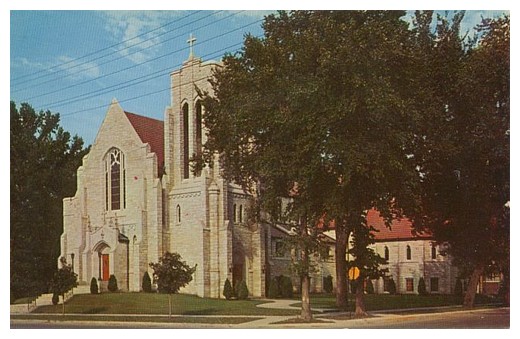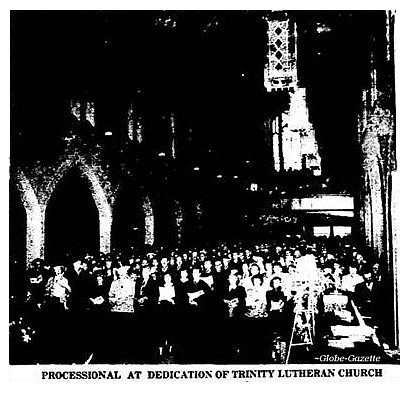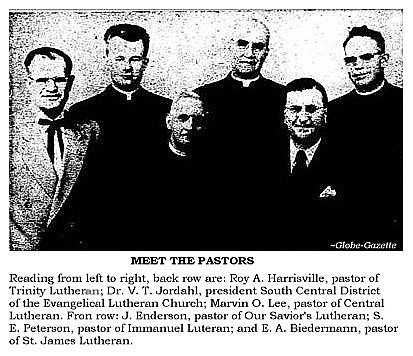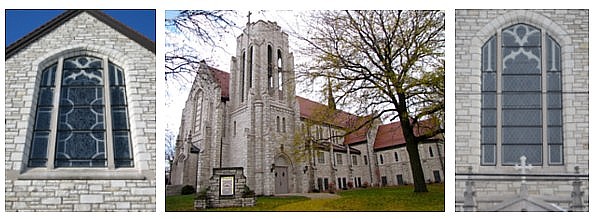


Cerro Gordo County Iowa
Part of the IaGenWeb Project
|
213 N. Pennsylvania Avenue, Mason City Mason Township, Cerro Gordo County, Iowa

Globe Gazette, Mason City, Cerro Gordo County, Iowa
While other church groups had no language tieups, the beginnings of the Lutheran Church were associated with the coming of families of Scandinavian and German descent to Mason City. The Scandinavians in July, 1871, organized Trinity Lutheran church at the home of Andrew Helgesen. The first deacons were Andrew Helgesen, Martin Andeberg, Peter Olson and A. T. Lien, and the trustees, Henry Bricksen and N. M. Nelson. The congregation was served by the Rev. Ostby of St. Ansgar and later by the Rev. O. Nilsen of Northwood. In 1888 the congregation joined with Austin and Hayfield, Minn., in a charge and procured the Rev. O. Glasoe as pastor. He was paid $125 and traveling expenses a year for a Sunday service each month. Up until 1890 the congregation was affiliated with the Norwegian Danish Conference of America, but on March 15 of that year it subscribed to the constitution of the United Norwegian Lutheran Church of America and sent A. T. Lien and Gust Nelson to the first annual meeting. In 1892 the congregation purchased the lot and the next year a church costing $2,474.94 was built by Chris Rye on the present [1953] site of the Labor Hall on Pennsylvania S. E.
"We are gathered here," said the pastor, "to organize a Lutheran congregation." Around him on crude chairs and benches in the pioneer home of Andrew HELGESEN in Mason City, Iowa, sat 16 thoughtful men. They were all Scandinavian immigrants, most of them from Norway, struggling to adapt themselves to the strange ways of their adopted land. The Lutherans had been welcomed in the mid 1850's by the Methodist and Congregational churches in Mason City, but many of the Scandinavians found the English services difficult to understand, and wanted their children to have Baptisms, Sunday School and worship in their native language. A special service was held on July 1, 1871, which witnessed the official signing of the Constitution for the formation of the Scandinavian Lutheran Church in Mason City. The members of 16 families signed the Constitution. Rev. Paul G. OSTBY held services in the courthouse, Parker Opera House, and other locations until 1874, when he resigned. Tough times followed for what is now Trinity Lutheran Church during the years from 1874 - 1906. The church reorganized many times and had a number of lay leaders, seminary students, and part-time or short term pastors who could come only monthly to Mason City. During the difficult years, however, the Ladies' Aid was formed July 2, 1886, and Sunday School was organized February 3, 1889. The Ladies' Aid was to prove an invaluable part of the congregation, and especially helped with finances. On July 2, 1892, the congregation purchased land at what is now the corner of 5th Street SE and S. Penn Avenue (the present site of the Mason City Labor Temple.) Trinity's first Church, erected at a cost of $2,484, was dedicated on May 3, 1894. On July 2, 1906 Trinity installed its first resident pastor, Rev. G. G. BELSHEIM. It was under Rev. BELSHEIM that Americanization of the congregation began. He held services in English and Norwegian. In 1908, the church's name was changed from Scandinavian to Trinity Lutheran with an immediate growth in membership. Rev. BELSHEIM became frustrated in his attempts to move the church to a better location, and resigned in 1915. He was succeeded by Rev. Richard M. VORDALE. VORDALE brought a burst of activities, designed to improve the morale of the congregation. By the time he resigned in 1921, the church membership had risen to over 600. VORDALE was succeeded in 1921 by Rev. Oliver L. N. WIGDAHL, who served until 1942. That tenure included the Great Depression, and WIGDAHL considered compassion for the needy and unchurched a most important part of his ministry.
Services the first year were held at Trinity Church, where many of the members had previously been affiliated. A lot was purchased at First and Jersey S. E. for $2,250 and a chapel built which served the congregation until in 1922, when under the leadership of the Rev. O. A. Elmquist, field missionary of the conference, plans were set in motion for the present [1953] church in 1923. In 1924 the parsonage was erected.
The following Sunday chairs had to be brought in to supplement the pews. In a few weeks the church became wholly inadequate for the crowds and services were transferred to the Palace Theater with the permission of Tom Arthur, then manager of the Blank Theater group. A building campaign got under way and gained momentum as it proceeded. On May 24, 1948, ground was broken for a $360,000 Norman Gothic church of Lannon stone. Two years later it was dedicated by Dr. J. A. Aasgaard, president of the Evangelical Lutheran Church. The church with a seating capacity of 1,100, was a significant milestone. It marked the fulfillment of a dream of Trinity members who had worshiped in the same little church they built in 1892 for $2,484. It meant also the transfer of the district headquarters of 182 churches to Mason city, with the office of the district president, the Rev. V. T. Jordahl, in the new church. The building of Trinity had another significance. It marked the beginning of the largest church building program in Mason City's history with the result that in the last five years more had been spent on church construction here than in all the previous 95 years of Mason City's history. In these five years a total of $3 million was spent on new churches.

[Section 8, Page 6] The dedication of the $365,000 Trinity Lutheran Church in Mason City June 18, 1950, marked the fulfillment of a longtime dream and the opening of new possibilities to thousands of Lutherans in this area. The dedication marked the completion of the first new church the congregation had had since the erection of a small structure on Pennsylvania S.E. in 1893. It marked the amazing fruition of seven years of leadership of the Rev. Alvin N. Rogness as pastor. But, as pointed out by Dr. J. A. Aasgaard, president of the Evangelical Lutheran Church, the completion of the church meant the establishment in Mason City of the headquarters for the south central district of the church with the Rev. V. T. Jordahl, district president, having his office in the new church. The district comprises all of Iowa and several states southward as far as Texas, with a heavy concentration of the membership in this area. Installation service for the new president took place in the church in the afternoon in charge of President Aasgaard with many distinguished clergymen from this area and from other parts of the country taking part. Pastor Jordahl's district comprises 70,000 church members.

Construction of the new church began with a ground breaking ceremony May 23, 1948. Handling the shovel for this ceremony was Ralph Nelson, son of Gust Nelson, one of the charter members when the Trinity congregation was organized in 1871. Also participating in the ceremony was Dr. Lloyd Gustafson of the First Methodist Church, president of the Ministerial Association. The launching of the construction was the culmination of a five year campaign to raise funds.
NOTE: Rev. Verner Trygve Jordahl was born in Minnesota on October 26, 1898, and died September
24, 1984. His wife, Norma (Johnson) Jordahl, was born in Ridgeway, Iowa, August 28, 1899, and died December 18, 1992. They
were interred at Madison Cemetery, Winneshiek County, Iowa.



It was under Rev. Alvin N. ROGNESS (1906-1992) that membership soared and the current church was built. Within 6 weeks of ROGNESS' arrival, the small facility at 5th St. S.E. and S. Penn. became too small to hold regular services. Arrangements were made for the free use of the Palace Theater, located at the present site of Southbridge Mall. While funds were being raised, services were held at the Palace Theater from October of 1942 until May of 1950 (seven years). It was obvious that a new facility would need to be built. On May 14, 1950 the congregation held its first services in their new facility. The old church at South Pennsylvania and Fifth was destroyed by fire on January 5, 1950, just as the congregation was to enter its new $350,000 building.

The cornerstone of the education unit was laid in 1960 with the construction of the three-story unit completed the following year. Pastor HANSON was very active in the community, and the A.L.C. Under HANSON, Trinity's membership continued to grow, until it reached nearly 4,000 in the early 1970's. Rev. Delmar JACOBSON took over as senior pastor of Trinity on December 1, 1984 and remained until June 1, 1991. Morris WEE filled in as interim pastor in 1991-1992 and John ROTTO in 1992. Rev. Chris HELLEVIK, took over as senior pastor at Trinity on January 1, 1993 and served Trinity's congregation until January 31, 2000. Rev. John W. GANNETT served as Interim Senior Pastor from January of 2000 through August 19th of 2001. Rev. James MAGELSSEN served Trinity Lutheran Church as Senior Pastor from August 26, 2001 to May 20, 2012. Rev. Duane MILLER began his service as Trinity's Interim Senior Pastor on July 1, 2012. Trinity celebrated its 140th Anniversary.

Globe Gazette
make room for church parking lot
The house was named after the Rev. Alvin RORGNESS, who was the church’s senior pastor from 1942-51 and the first pastor when the church’s current building opened in 1950.
Youth Director Marcy COLVIN said the house, built in 1924 for $6,000, was previously a parsonage. The Rogness House was used for confirmation small groups, high school Sunday school and Youth Group It will be replaced with a parking lot for the church.

SOURCES: Trinity Lutheran Church, Mason City; The Globe Gazette, Mason City IA
|
Return to Cerro Gordo Church Index Page Return to Cerro Gordo Home Page